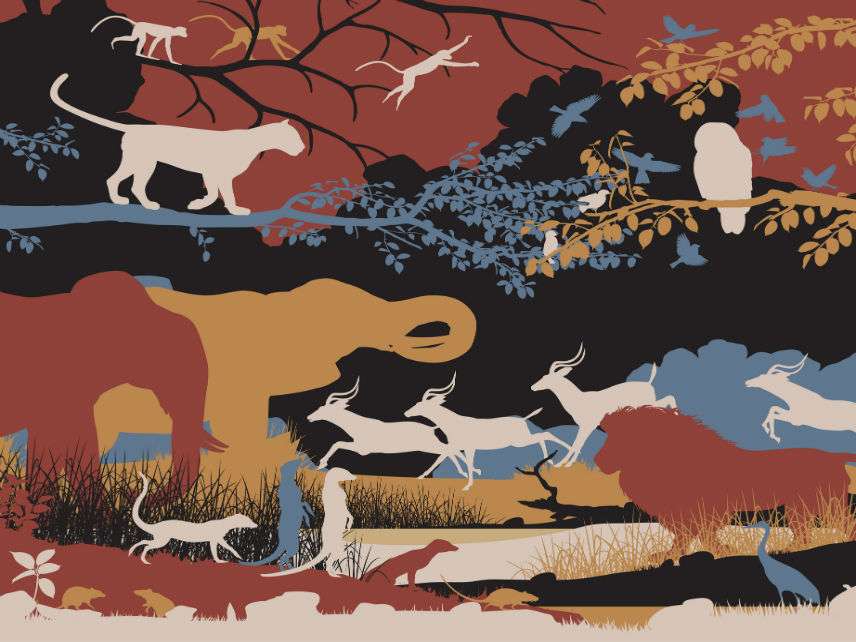The Coming Century of Environmental Renewal
A new article in BioScience vindicates The End of Doom.

Modern environmentalism preaches unrelenting gloom and doom both for people and for the planet. A typical example is this Guardian headline last month: "Collapse of civilization is a near certainty within decades." The article reported the reliably wrong population doomster Paul Ehrlich's latest predictions of global ecological disaster.
But while doom remains the dominant worldview among environmentalists, some vanguard thinkers are beginning to take notice of the strong trends toward environmental renewal that the increasing wealth produced by markets and technological innovation are making possible. In the latest issue of the journal BioScience, three researchers from the Wildlife Conservation Society argue that over the course of this century increasing wealth and urbanization will enable the global restoration of wild nature.
From the article:
For the first time in the Anthropocene, the global demographic and economic trends that have resulted in unprecedented destruction of the environment are now creating the necessary conditions for a possible renaissance of nature. Drawing reasonable inferences from current patterns, we can predict that 100 years from now, the Earth could be inhabited by between 6 and 8 billion people, with very few remaining in extreme poverty, most living in towns and cities, and nearly all participating in a technologically driven, interconnected market economy. Building on the scholarship of others in demography, economics, sociology, and conservation biology, here, we articulate a theory of social–environmental change that describes the simultaneous and interacting effects of urban lifestyles on fertility, poverty alleviation, and ideation. By recognizing the shifting dynamics of these macrodrivers, conservation practice has the potential to transform itself from a discipline managing declines ("bottleneck") to a transformative movement of recovery ("breakthrough").
These predictions are nearly identical those I made in my 2015 book, The End of Doom: Environmental Renewal in the Twenty-First Century:
THE END OF THE WORLD IS NOT NIGH. Far from it. Humanity does face big environmental challenges over the course of the coming century, but the bulk of the scientific and economic evidence shows that most of the trends are positive or can be turned in a positive direction by further enhancing human ingenuity. Let's briefly review that evidence and those trends.
Human population growth is slowing and will very likely peak at around 8 to 9 billion in this century and begin falling. This virtuous trajectory is the result of a combination of happy developments, not the least of which is expanding education and oppportunities for girls and women around the world. The process of economic growth reduces child mortality, which in turn encourages parents to have fewer children and invest more in their health and education. Increasing agricultural productivity ameliorates hunger and liberates people from the fields to seek better opportunities in cities. Rising agricultural yields that result from the application and spread of modern farming technologies, most especially including biotechnology, also means that the amount of land devoted to crops and pasturage is shrinking. Humanity has already likely reached "peak farmland," which means that huge swaths of land will be restored to wild nature over the course of this century. …
Assuming that world population grows to 9 billion by 2050 and that 80 percent do live in cities, that would mean that only 1.8 billion would be on the landscape, as compared to 3.6 billion today. If world population tops out at 8 billion, then only 1.6 billion people would live in the countryside—2 billion fewer people than live there now. …
As people abandon the landscape, this greatly enhances the prospects for protecting and preserving the planet's biodiversity.
People at the end of the century will be much wealthier than we are today….Average income per person globally will have increased from around $10,000 today to $60,000 by 2100. US annual incomes would average just over $100,000. That amount of wealth enables people to buy a lot in the way of health, education, and wild nature. …
New technologies and wealth produced by human creativity will spark a vast environmental renewal in this century. Most global trends suggest that by the end of this century, the world will be populated with fewer and much wealthier people living mostly in cities fueled by cheap no-carbon energy sources. As the amount of land and sea needed to supply human needs decreases, both cities and wild nature will expand, with nature occupying or reoccupying the bulk of the land and sea freed up by human ingenuity. Nature will become chiefly an arena for human pleasure and instruction, not a source of raw materials. I don't fear for future generations; instead, I rejoice for them.
I am delighted that folks from the Wildlife Conservation Society now recognize that global ecological restoration depends upon alleviating poverty by spurring economic growth and technological innovation through markets. I hope that they will be able to persuade the broader environmentalist movement to abandon its attachment to counterproductive policies that slow growth, perpetuate poverty, and ultimately fail to protect and preserve wild nature.
For more background, see also my article "The Invisible Hand of Population Control" and my review of biologist Chris Thomas' superb book Inheritors of the Earth: How Nature Is Thriving in an Age of Extinction. In addition, you may want to view my 11-minute talk on the subject at Voice & Exit:


Show Comments (23)